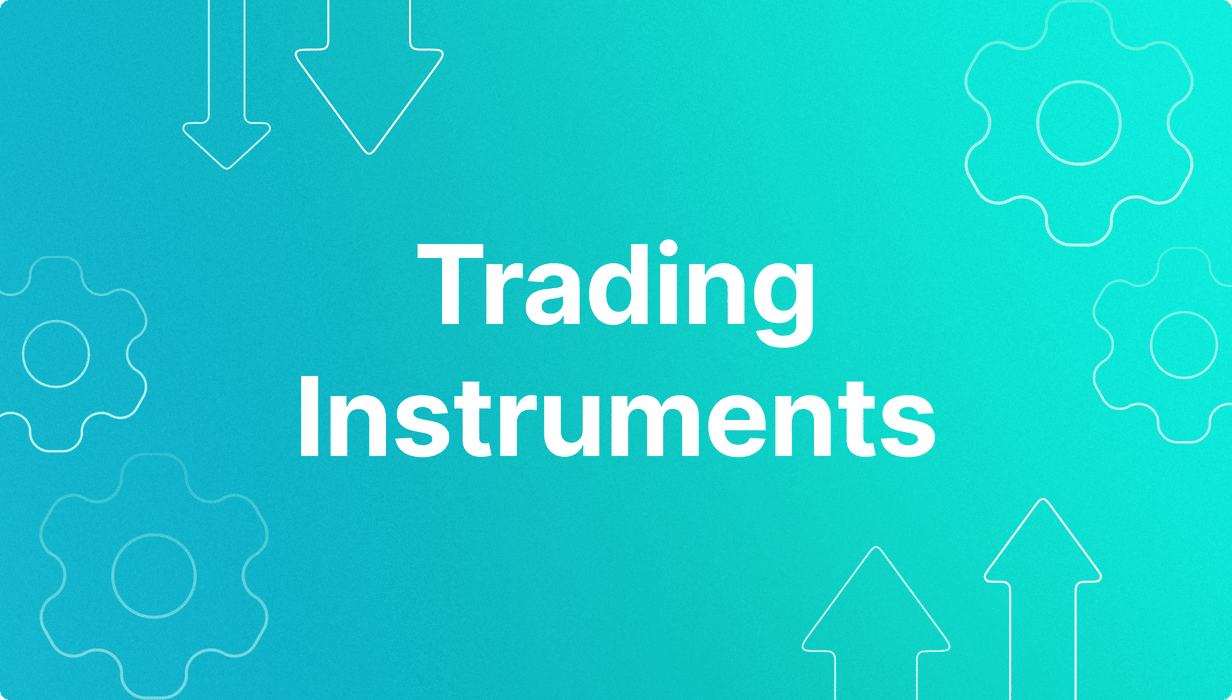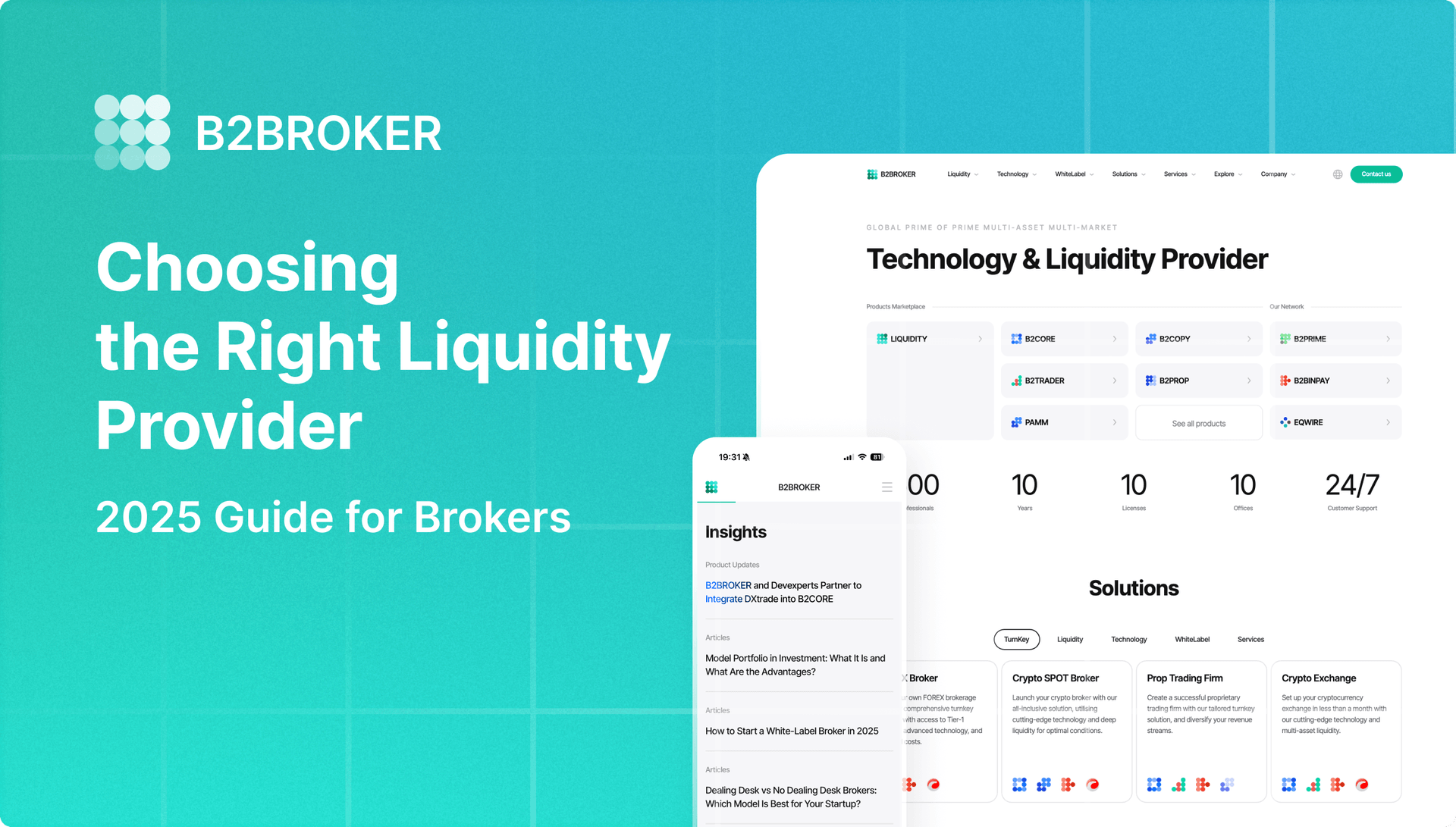The Most Popular Trading Instruments Brokers Should Be Aware of

Brokers today operate in an environment where offering a limited set of instruments is no longer viable. Traders expect diversified portfolios, tight spreads, deep liquidity, and institutional execution across a wide range of asset classes. That’s why your choice of trading instruments — and the liquidity behind them — is directly tied to your business growth.
This article outlines the instruments that drive volume, build retention, and increase lifetime client value — and shows how to integrate them via a unified, multi-asset liquidity solution.
Key Takeaways
- Traders demand access to multi-asset markets: crypto, FX, stocks, indices, ETFs, metals, and more.
- Offering high-demand, high-liquidity instruments drives revenue, retention, and AUM.
- Multi-asset liquidity gives brokers an edge by attracting diversified trading profiles.
- B2BROKER provides institutional-grade liquidity across 10 asset classes from a single margin account.
Why Your Instrument Offering Defines Your Business
The choice of trading instruments is a core part of a broker’s positioning and a key factor in user acquisition, activation, and retention.
Here’s why:
- Retail traders are becoming multi-asset participants. It’s increasingly common for the same user to trade crypto on Sunday, oil on Monday, and Nasdaq ETFs on Wednesday.
- Markets are open around the clock. With crypto, synthetic indices, and perpetual futures contracts, traders expect non-stop access and constant volatility to profit on both rising and falling markets.
- Asset cycles rotate faster. Traders shift capital quickly in response to macro signals, looking for short-term opportunities in whichever market is moving.
If your platform doesn’t support the asset class they’re rotating into, they’ll move capital elsewhere. Even worse, they may never return. Traders now expect access to multiple markets as a baseline. Failing to meet that expectation means falling behind.
Have a Question About Your Brokerage Setup?
Our team is here to guide you — whether you're starting out or expanding.
How to Define a “Popular” Trading Instrument Today
Volume alone doesn’t explain why certain instruments consistently attract trader interest. While daily turnover is useful for understanding the size of a market, it tells you little about how relevant that market is to your specific clients.
In 2025, brokers must evaluate popularity through the lens of usability, volatility, access, and timing. That means asking questions like:
- Do traders know this instrument well enough to trade it confidently?
- Can they access it easily, in terms of pricing, lot size, and capital requirements?
- Does the asset respond to news and events in ways that create clear trading setups?
- Is liquidity consistent across time zones, or concentrated in short windows?
- Are traders using it tactically (short-term) or strategically (portfolio positioning)?
An asset becomes “popular” not just because of what it is, but because of how it behaves in the hands of your clients. A particular currency pair with tight spreads and macro exposure may be ideal for day trading. A volatile altcoin might appeal to momentum traders on weekends. A large-cap stock can serve long-term holders and scalpers depending on how it’s packaged.
The real challenge is matching the right instruments to the habits and goals of your client base. That requires going deeper than instrument type. You need to understand how and why a specific asset earns its place on your platform.
Some brokers go further and track what percentage of registered users actually trade each asset class in the first 30 days. Others monitor retention and funding patterns by asset type. Both approaches work. What doesn’t work anymore is assuming that high-volume markets are automatically the right ones to offer.
So, what are the most popular trading instruments every broker should be aware of?
Forex Trading: Still the Foundation of Financial Markets
Despite the rise of multi-asset trading platforms, Forex trading continues to play a central role in most brokerage models. It remains one of the few asset classes that combines massive liquidity, continuous market coverage, and consistent volatility.
Major pairs (two currencies) like EUR/USD and USD/JPY are not only familiar to most traders — they also provide efficient pricing, strong macro sensitivity, and tight execution windows. They are ideal for high-frequency trading strategies and are easy to integrate into both manual and automated workflows.

But popularity doesn’t mean complacency. Traders in currency markets are often technically sophisticated and highly sensitive to issues like spread widening, slippage, and news-hour execution. When latency or pricing falls short, these traders react immediately — and often permanently.
For brokers, foreign exchange markets are still the entry point for many first-time depositors. It also remains a key battleground for retention and lifetime value, especially when paired with algorithmic trading infrastructure, flexible leverage, and quality education.
Brokers rarely lose clients because they didn’t offer Euro / US Dollar. But they often lose them because they offered it with a 2-pip spread and unreliable fills.
Access deep, institutional-grade liquidity across 10 asset classes by B2BROKER — with ultra-low latency and a single margin account.
Crypto: Mainstream, Not Optional
In 2025, crypto is fully integrated into mainstream trading. Most brokers now offer at least a basic set of crypto instruments. But offering access isn’t the same as meeting expectations.
Today’s experienced traders demand 24/7 execution, deep liquidity on majors, and exposure to fast-moving speculative assets. Bitcoin and Ethereum still dominate volume, but tokens like Solana, Avalanche, and meme coins regularly surpass them in short bursts. Platforms that can’t move quickly enough to onboard new assets risk losing users in hours, not months.

Crypto also changed how and when people trade. Weekends are now live market time. Trading sessions extend into nights. For many users under 35, crypto was their first financial instrument — and it’s the one they trust most.
To serve this segment, brokers must ensure more than just listings. The infrastructure must support stable execution, competitive spreads, fast price feeds, and flexible funding in crypto-native assets like USDT, BTC, and ETH.
Metals: Reliable During Uncertainty
Gold and silver remain staples of most trading platforms, but their role has evolved. They are not only “safe havens” but also tactical assets, used for both hedging and directional speculation.
Gold (XAU/USD) performs particularly well in macro-driven cycles: inflation spikes, monetary tightening, and geopolitical stress. It also reacts cleanly to economic data, which makes it attractive for short-term traders who use event-based setups. Silver (XAG/USD) offers sharper moves and appeals to those seeking volatility with a fundamental overlay.
Trading activity in metals tends to increase when other currency or fund instruments stall. When equities range, when FX volatility fades, or when crypto corrects, traders rotate into metals — often aggressively.
Execution expectations here mirror those in FX: tight spreads, high fill rates, and transparent swap conditions. The products are familiar, but the investors using them are highly selective.
Metals aren’t always the most traded instruments. But they’re often the most traded when it matters — during risk-off events, crisis cycles, or flight to safety.
Equities: From Investing to Trading
Stocks have always been a long-term investment vehicle. But in recent years, they’ve fully entered the short-term trading space. Today’s retail clients are scalping earnings reports, trading news, and speculating on short-term moves.
Tech stocks, in particular, draw massive attention. Companies like Amazon, Nvidia, Tesla, or Spotify (which Goldman Sachs analysts project will continue growing, citing rising engagement and stronger pricing power) often move more in a week than traditional indices do in a month. This attracts momentum traders, retail flow, and algorithmic strategies.

Many brokers now offer fractional share trading, making equities more accessible to smaller accounts. Others use synthetic or CFD-based models to offer leverage and shorting.
For brokers, equities open the door to clients who want exposure to real-world companies and events — and who may not feel comfortable starting with FX or crypto. Just as importantly, the stock market tends to drive media attention, which helps with marketing and onboarding.
Exchange Traded Funds (ETFs): Low-Cost Access, High Engagement
In recent years, exchange traded funds, or ETFs, have become popular among short-term traders, thanks to thematic exposure, daily rebalancing, and lower volatility profiles.
Products like the VanEck Semiconductor ETF (SMH) or the Invesco S&P 500 Equal Weight ETF (RSP) give traders access to sectors without the need to pick individual stocks. That appeals to both new users and macro-driven professionals.
Brokers that offer ETF trading — especially with flexible lot sizing and leverage — gain access to a growing segment of retail users who want to trade news cycles and economic trends, but with a low volatility profile compared to single-name equities.

ETFs also pair well with copy trading, portfolio tools, and longer-term trading strategy, helping brokers drive retention and cross-sell potential.
ETFs are the middle ground — safer than crypto, more structured than FX, and more diverse than single stocks.
Looking for a multi-market platform that keeps up with your instruments? B2TRADER is built for brokers and exchanges who want to offer FX, crypto spot and futures contract agreements, indices, metals, and more — all from a single frontend with unified liquidity.
Indices: High Volume, High Reactivity
Indices like the S&P 500, Nasdaq 100, DAX, and FTSE are some of the most actively traded instruments on many platforms, not because of what they represent, but because of how they behave.
Traders gravitate toward indices for one reason: they move. News events, earnings seasons, and macroeconomic data all impact index pricing in clear, directional ways. These assets are perfect for technical analysis, short-term breakouts, and volatility-based strategies.
Instruments like US30 or GER40 also offer predictable liquidity windows, especially around open and close times in the New York Stock Exchange.
Offering indices with tight spreads, reliable execution, and extended trading hours is an easy way for brokers to retain day traders who want market exposure without managing stock-specific risk.
Indices are ideal for traders who follow markets closely but don’t want to pick winners.
Commodities: Macro in Motion
Commodities — particularly oil, natural gas, and agricultural contracts — have become essential instruments for brokers serving clients in emerging markets, energy-exporting regions, or anywhere macro volatility is top of mind.
Oil is the standout. It combines:
- Global relevance
- High intraday volatility
- News-driven spikes
- Cross-market impact on currencies, indices, and inflation hedges
Natural gas offers even more price movements, though it appeals to a more experienced crowd. Soft commodities (like wheat, corn, or coffee) attract traders during specific geopolitical or seasonal events.
For brokers, commodities expand the range of narratives you can support. When oil surges, traders want in. When OPEC meets, spreads widen and volume spikes. Platforms that can handle that flow earn trust and volume.
Building the Right Trading Product Offering
Knowing what to offer is only part of the equation. The other part — often the harder one — is deciding how to structure your trading lineup in a way that’s aligned with your audience, operational capacity, and long-term goals.
Start With Audience Segmentation
Every trader segment behaves differently. Their preferences, goals, and risk tolerance directly affect how they use your platform.
Retail beginners often look for simplicity, brand recognition, and safe choices. For them, majors in FX, gold, and fractional equities are natural entry points. If you overwhelm them with 200 crypto tokens or exotic currency pairs, they’re more likely to drop off than to engage.
Active traders — including scalpers and intraday users — care deeply about spreads, slippage, execution times, and platform stability. They often gravitate toward FX, indices, and high-volatility assets like oil or BTC. These users will test your infrastructure with their style — and leave if it fails.
Crypto-native users expect 24/7 markets, fast-moving tokens, meme coin listings, and USDT-based collateral. If your crypto offering feels static, late, or built around traditional trading hours, you’re missing the mark.
Professional and high-volume clients focus on margin conditions, swap transparency, instrument depth, and integration with external tools. For this group, asset coverage must go hand-in-hand with execution quality.
Prioritise Instruments With Proven Stickiness
Some assets naturally lead to longer trading sessions, repeat visits, and higher deposit activity. These instruments often have the following traits:
- Recognisability (BTC, XAU/USD, EUR/USD, AAPL)
- Intraday volatility, with clear price levels
- News or event-driven movement
- Available around the clock or across time zones
Tracking metrics like time per session, financial market trades per user, and re-deposit rates by asset gives brokers a clear sense of what drives retention — and what’s just “filler” on the platform.
Infrastructure Comes Before Asset Count
Many brokers make the mistake of chasing quantity, launching hundreds of instruments without the infrastructure to support them.
This approach backfires. It leads to slow feeds, execution issues, downtime, and support requests from frustrated traders who are unable to make informed trading decisions. Worse, it erodes brand trust.
Before adding more instruments, make sure you can deliver:
- Consistent spreads and low latency
- Accurate, timely price feeds across regions
- Real execution capacity, not just market coverage
- Swap conditions and leverage logic that make sense per asset class
- Cross-asset margin and risk management tools
Being multi-asset means delivering every listed instrument at a standard your traders can rely on. It is always better to offer 50 instruments with high-quality execution than 300 with disclaimers and gaps.
Build With Flexibility in Mind
Markets change, and so will your clients. You’ll need to add and remove tokens based on market relevance, adjust leverage and trading conditions dynamically and reweight your promotion strategy by season (e.g. oil in winter, gold during inflation spikes). Moreover, you need to adapt to regulations without disrupting the user experience.
The brokers that scale best are the ones that build their offering around modularity, where asset classes can evolve independently, but share the same liquidity, risk control, and account structure.
One Connection. Ten Asset Classes. Full Coverage.
As trader expectations rise, brokers face the growing challenge of offering more markets without compromising quality. Supporting crypto, FX, metals, indices, and equities — all with consistent pricing, execution, and stability — requires infrastructure built for scale.
Many brokers try to piece this together from multiple providers, but that approach leads to fragmented risk systems, uneven liquidity, and mounting operational costs.
At B2BROKER, we solve this by providing deep, institutional-grade liquidity across 10 asset classes, all accessible from a single multi-currency margin account. You don’t need multiple providers, multiple feeds, or separate accounts. Everything is connected — efficiently, securely, and globally.
Liquidity Across 10 Asset Classes by B2BROKER
Our solution covers:
- Forex — 100+ currency pairs with dynamic leverage
- Crypto CFDs — 130+ trading pairs, deep liquidity on majors, minors, and trending tokens
- Precious Metals — gold, silver, and more with tight spreads
- Indices — global benchmarks, high reactivity
- Energies — oil and natural gas with macro sensitivity
- Equities — leading stocks with synthetic or fractional access from global stock exchanges
- ETFs — thematic baskets for retail and portfolio traders
- Commodities — including agricultural softs and industrials
- NDFs (Non-Deliverable Forwards) — emerging-market FX pairs with settlement risk removed
- Fixed Income — bond market exposure for portfolio diversification and risk control

Whether launching or scaling a brokerage, choosing the right liquidity provider is essential. See why B2BROKER is a trusted leader in liquidity solutions.
28.05.25
With ultra-low latency execution, FIX API access, and full compatibility with platforms like MetaTrader*, cTrader, B2TRADER, and third-party hubs like OneZero and PrimeXM, the setup is fast, scalable, and fully supported by our team.
Discover the Tools That Power 500+ Brokerages
Explore our complete ecosystem — from liquidity to CRM to trading infrastructure.
Bottom Line
Adding financial instruments is easy. Offering the right ones — with the execution, liquidity, and stability your clients expect — is what actually makes the difference. The brokers that grow in 2025 will be those who stay focused on variety, depth, speed, and user needs across every asset class they support.
Ready to offer 10 asset classes from one connection? Get in touch to explore institutional-grade liquidity, platforms, technology, and full infrastructure for modern multi-asset businesses.







